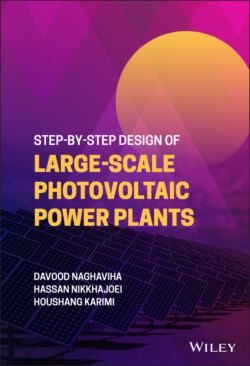Читать книгу Step-by-Step Design of Large-Scale Photovoltaic Power Plants - Houshang Karimi - Страница 10
Preface
ОглавлениеThe sun is the greatest source of energy and the root of other energy types. This fireball, the sun, was created about 4.603 billion years ago. Every second 2.4 million tons of the sun's mass is converted into energy. Solar energy can directly or indirectly be converted to other forms of energy, such as heat and electricity. Solar energy is used for water heating, space heating, drying of agricultural products, and electricity generation. The main obstacles to the use of solar energy include its intermittency and wide distribution.
Since the beginning of the past decade, the solar energy industry has grown up rapidly. The rapid growth has happened due to the advancement in the solar panel and inverter technology and the decrease of the solar equipment costs. The solar energy industry growth has been happening since a decade ago to address the world energy needs and to replace the conventional power plants. The fossil‐fueled and atomic power plants have created environmental disasters by daily emission of tremendous amounts of carbon.
To provide sufficient supply for the global energy consumption, a cumulative amount of 18 TW of photovoltaic power plants should be installed. This means the solar energy industry has a long way to reach to a point where at least 10% of the world energy consumption is generated by solar plants. As statistics shows, by the end of 2020, the installed capacity of world photovoltaic plants has reached to more than 751 GW. This indicates an increase of about 18.5% from the total of 634 GW solar plants that had been installed by the end of 2019.
Due to the increasing number of photovoltaic (PV) plant installations, there is a higher demand for feasibility studies and detailed designs of large‐scale PV power plants (LS‐PVPPs). It is necessary to do the feasibility study and detailed design using a systematic and organized method. This book provides step‐by‐step design of large‐scale PV plants by a systematic and organized method. Numerous block diagrams, flow charts, and illustrations are presented to demonstrate how to do the feasibility study and detailed design of PV plants through a simple approach.
This book includes eight chapters. Chapter 1 gives an overview of different applications and categories of solar energy, as well as the projections on the development of PV power plants worldwide. The current PV development shows a promising increase in the energy market investment despite the financial uncertainties during the Covid‐19 pandemic. Chapter 2 presents the design requirements and the major phases in designing a LS‐PVPP. In Chapter 3, feasibility studies are discussed in which the requirements for implementing a PV plant are evaluated from technical, legal, and economic points of view. Technical issues and existing standards related to grid connection points are studied in Chapter 4, where comprehensive technical studies are carried out using advanced simulation software based on the national network codes. Chapter 5 conducts a comprehensive discussion on radiometric terms, arrangement of solar resources, and main parameters of solar energy radiation. A detailed review on engineering documents and their classification for LS‐PVPP projects is presented in Chapter 6. Main components of the DC subsystem and its designing criteria are provided in Chapter 7, and finally Chapter 8 categorizes and explains different sources of power loss in PV power plants. Energy yield prediction and its influencing factors are also discussed in this chapter.
